Abstract
A new canine model of endotoxin shock has been developed in which spontaneous recovery of cardiovascular function is largely prevented, the haemodynamic effects of anaesthesia are minimized and intravascular volume replacement is given. This model has been evaluated using two groups of five adult mongrel dogs anaesthetized with alpha-chloralose and breathing spontaneously. Animals in one group were anaesthetized, instrumented and given Escherichia coli (E. coli) endotoxin intravenously, whilst those in the control group were subjected only to anaesthesia and instrumentation. E. coli endotoxin was given to dogs in the shock group as a bolus dose of 5 mg kg-1 followed by a continuous infusion at 2 mg kg-1 h-1. This produced immediate, severe, cardiovascular depression, with precipitous falls in mean arterial pressure (MAP), cardiac index (CI), stroke index (SI) and left ventricular (LV) dp/dt max. There were associated increases in systemic and pulmonary vascular resistances. Arterio-venous oxygen content difference (C(a-v)O2) increased after induction of shock, and animals developed a progressive metabolic acidosis. Increasing haemoconcentration occurred, as evidenced by a rising haematocrit (PCV). Hypovolaemia was reflected by a concurrent fall in pulmonary capillary wedge pressure (PCWP). One hour after induction of shock, intravascular volume replacement was given in the form of a colloidal gelatin solution, as a bolus dose of 10 ml kg-1, followed by a continuous infusion at 10 ml kg-1 h-1. Volume replacement reversed haemoconcentration, restored PCWP and produced some haemodynamic improvement, although in general, severe cardiovascular depression persisted throughout a three hour observation period. This severe endotoxin shock model has proved to be stable, reproducible and economical.(ABSTRACT TRUNCATED AT 250 WORDS)
Full text
PDF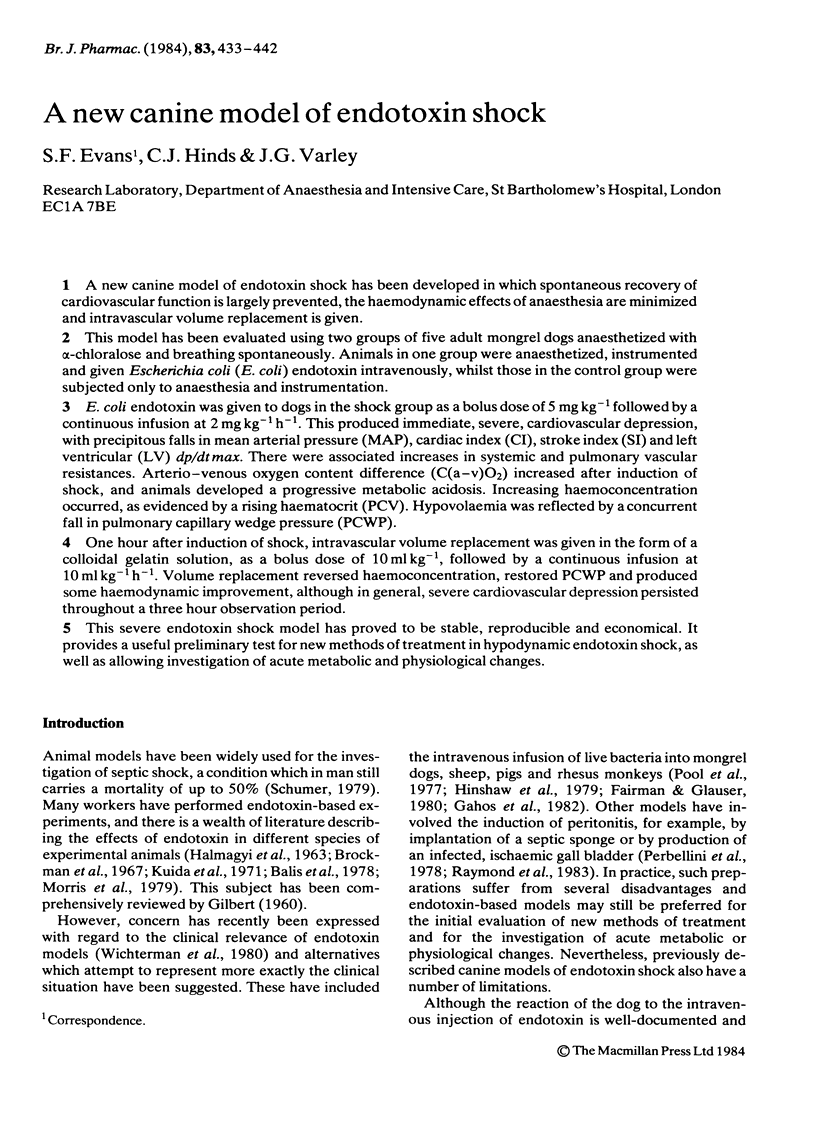
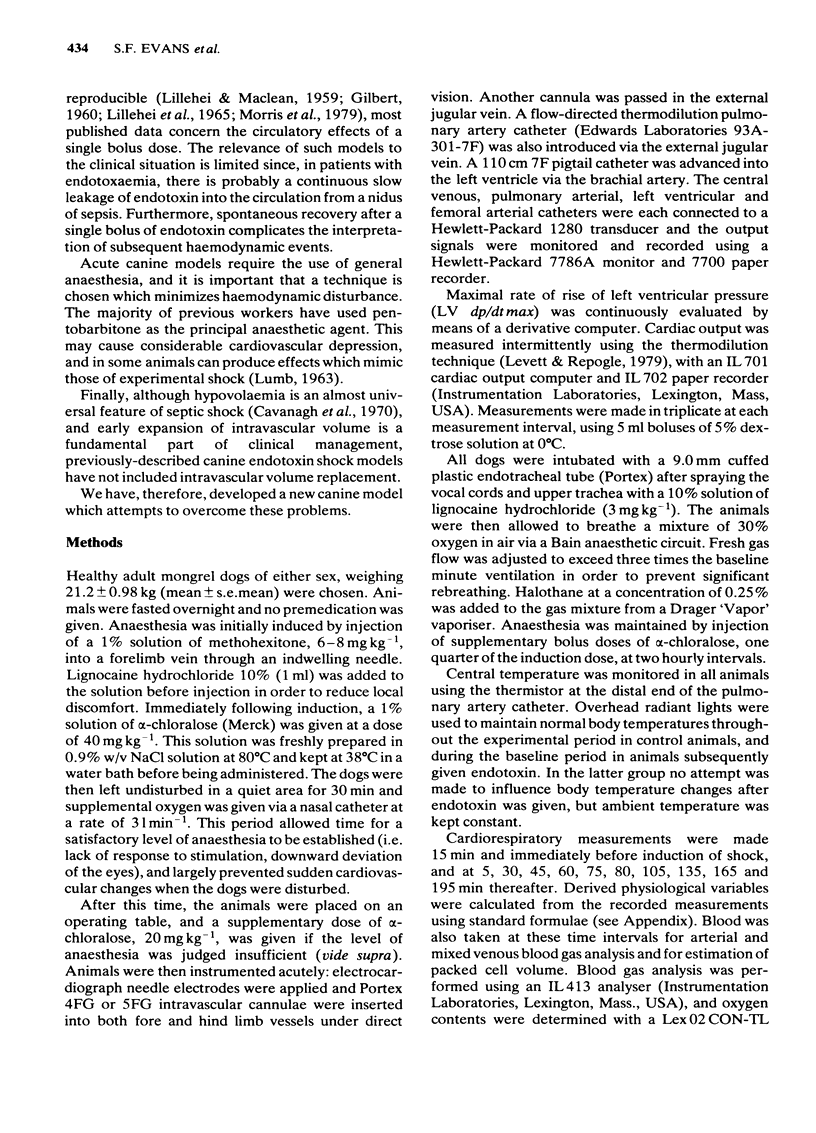

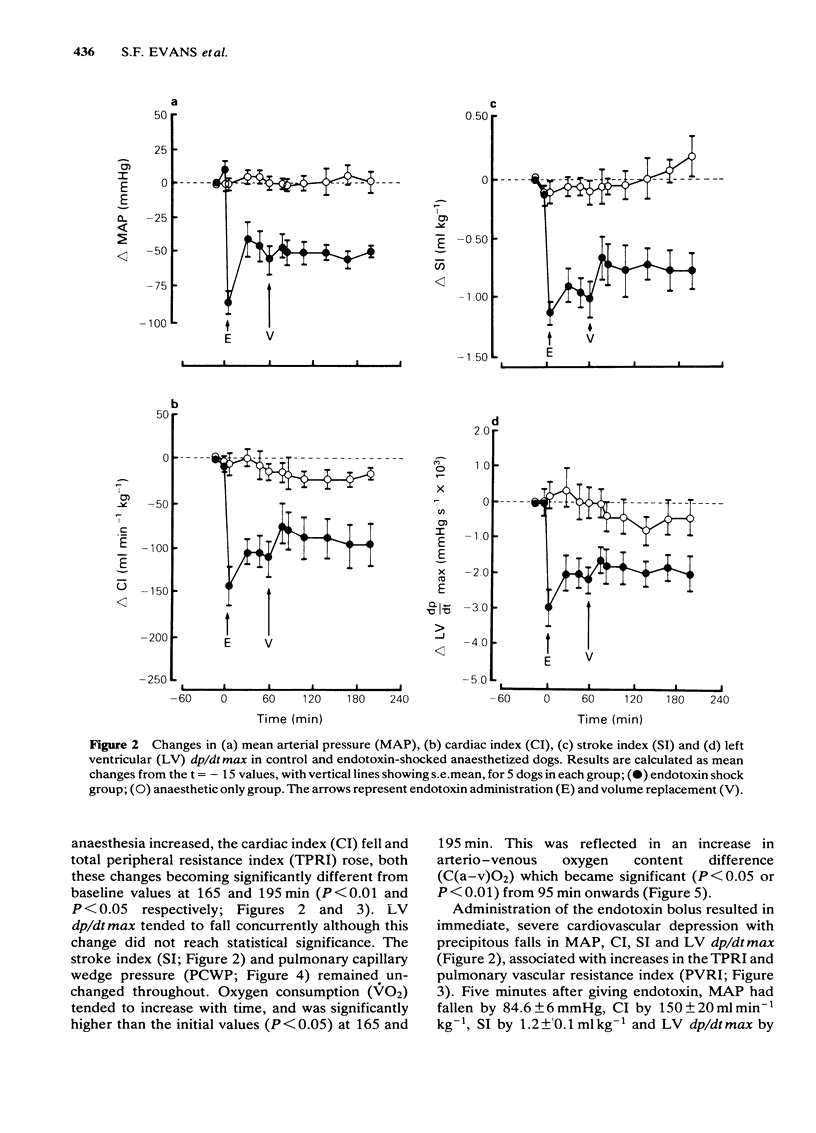
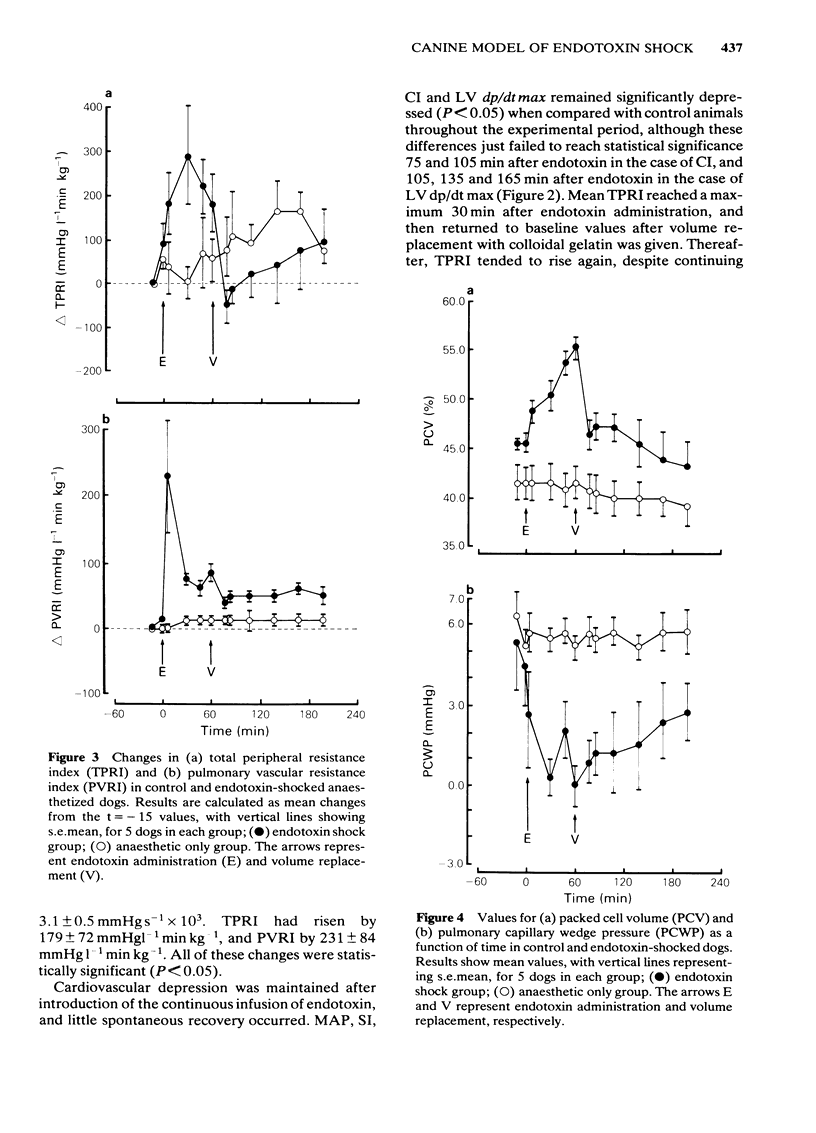
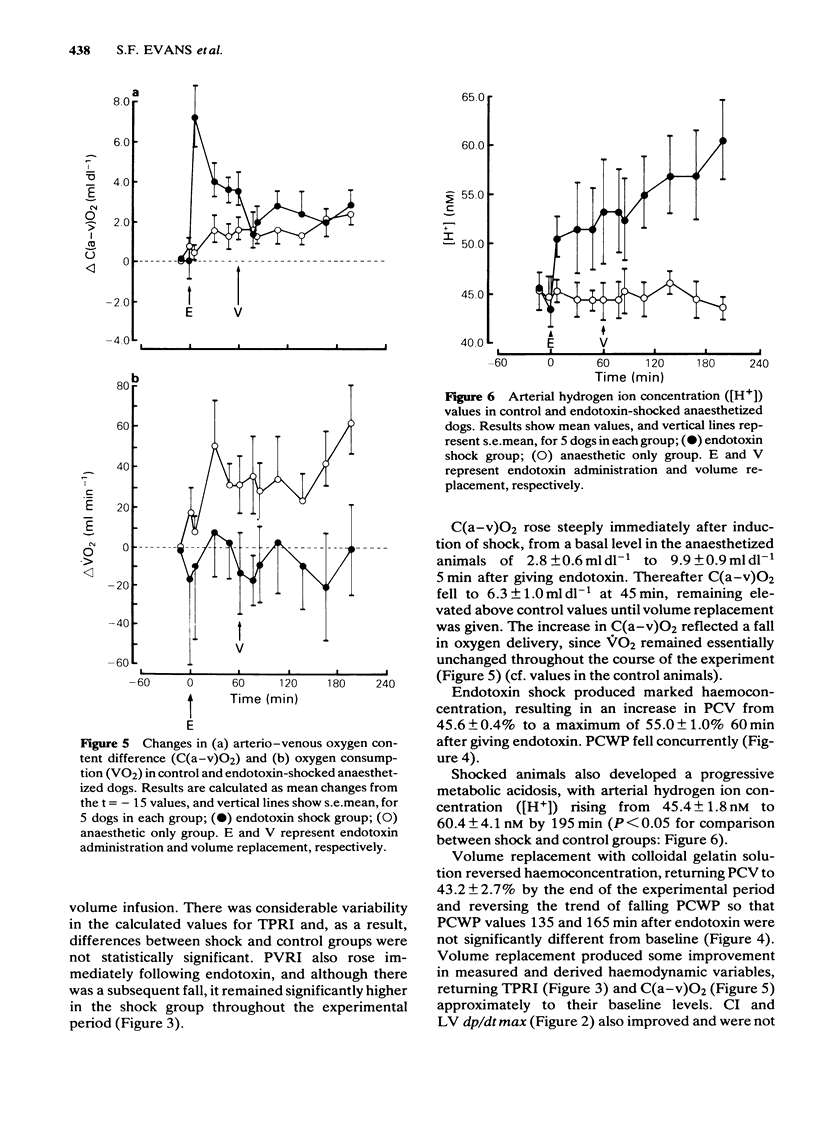
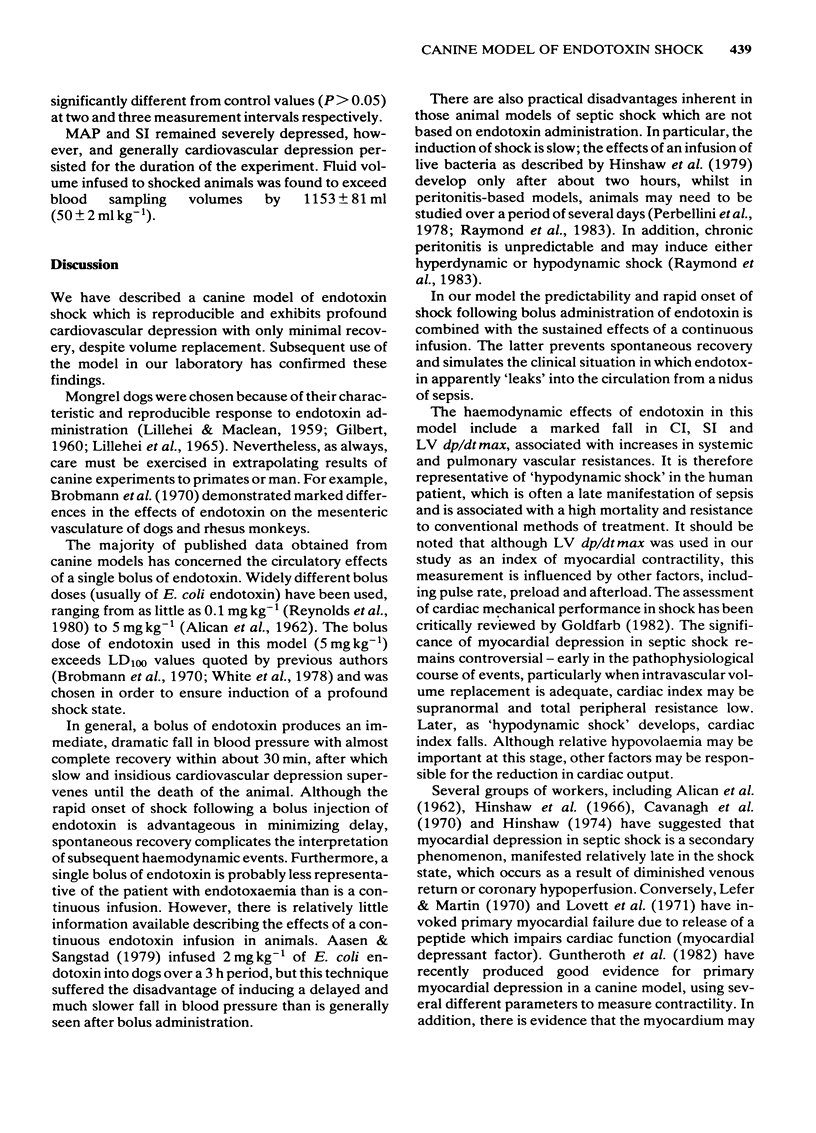
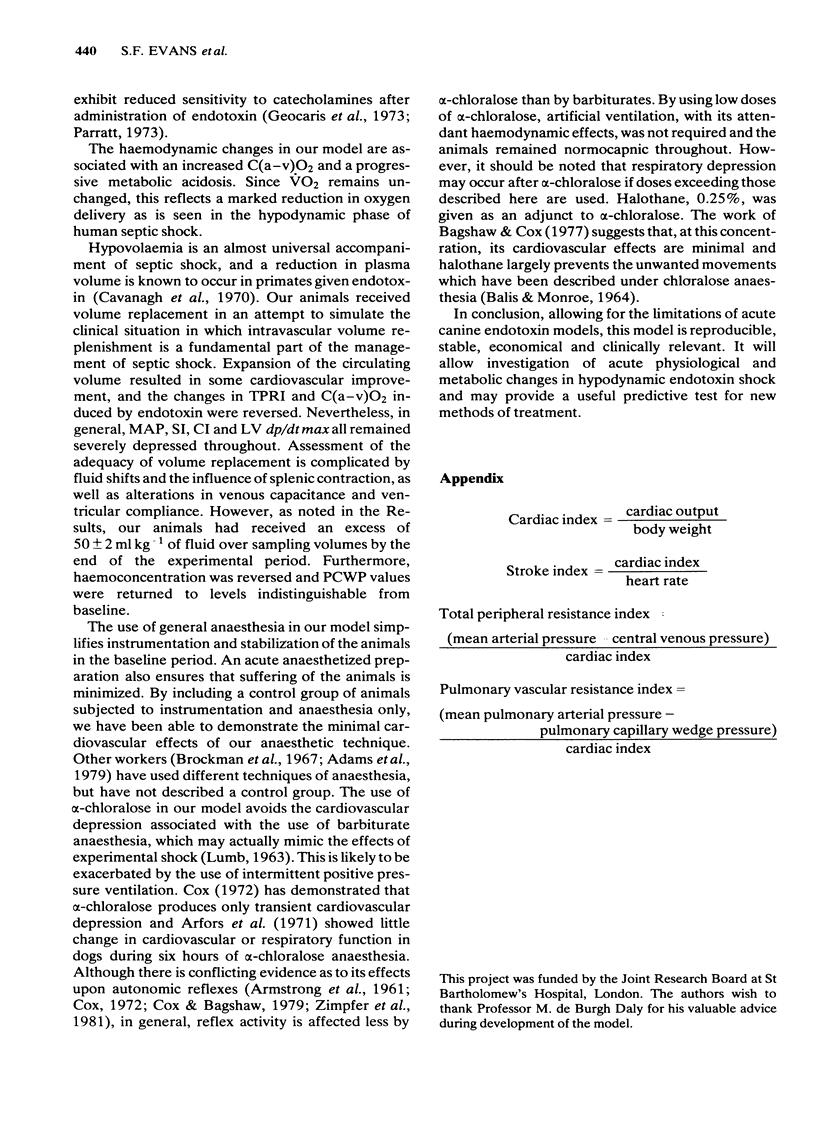
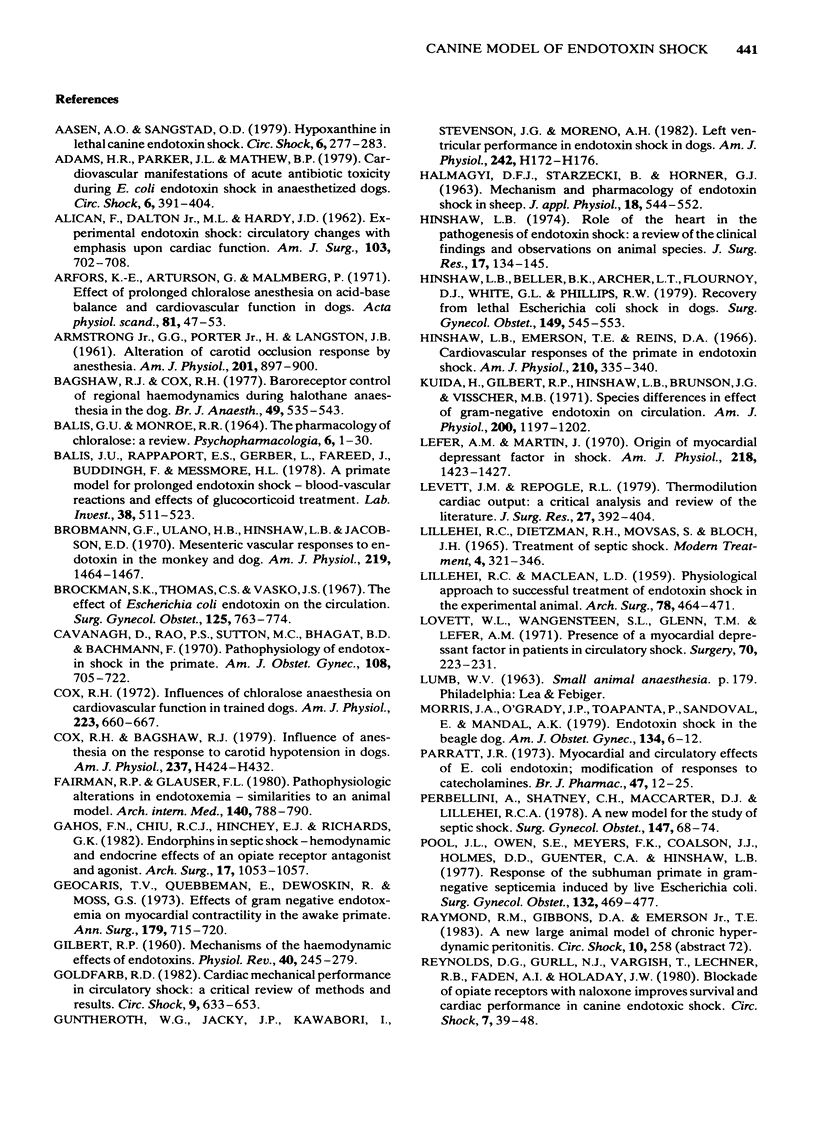
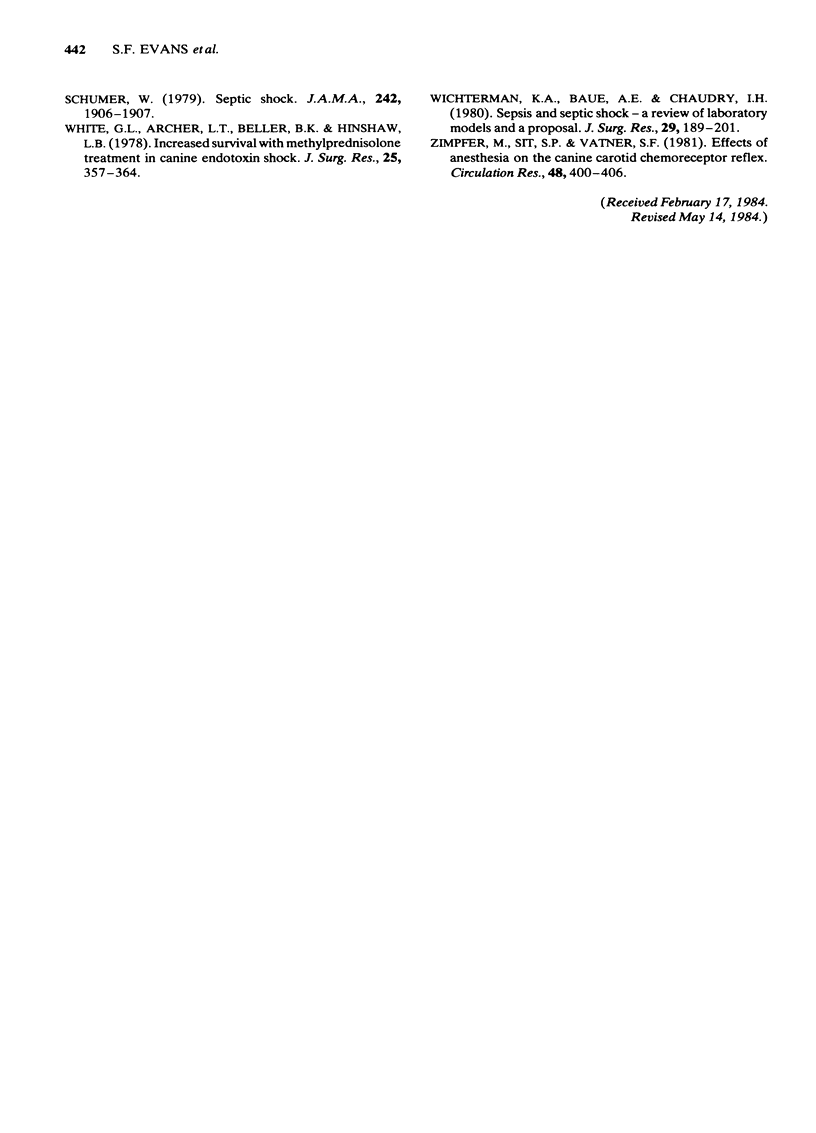
Selected References
These references are in PubMed. This may not be the complete list of references from this article.
- ALICAN F., DALTON M. L., Jr, HARDY J. D. Experimental endotoxin shock. Circulatory changes with emphasis upon cardiac function. Am J Surg. 1962 Jun;103:702–708. doi: 10.1016/0002-9610(62)90249-0. [DOI] [PubMed] [Google Scholar]
- ARMSTRONG G. G., Jr, PORTER H., Jr, LANGSTON J. B. Alteration of carotid occlusion response by anesthesia. Am J Physiol. 1961 Nov;201:897–900. doi: 10.1152/ajplegacy.1961.201.5.897. [DOI] [PubMed] [Google Scholar]
- Aasen A. O., Saugstad O. D. Hypoxanthine in lethal canine endotoxin shock. Circ Shock. 1979;6(3):277–283. [PubMed] [Google Scholar]
- Adams H. R., Parker J. L., Mathew B. P. Cardiovascular manifestations of acute antibiotic toxicity during E coli endotoxin shock in anesthetized dogs. Circ Shock. 1979;6(4):391–404. [PubMed] [Google Scholar]
- Arfors K. E., Arturson G., Malmberg P. Effect of prolonged chloralose anesthesia on acid-base balance and cardiovascular functions in dogs. Acta Physiol Scand. 1971 Jan;81(1):47–53. doi: 10.1111/j.1748-1716.1971.tb04876.x. [DOI] [PubMed] [Google Scholar]
- Bagshaw R. J., Cox R. H. Baroreceptor control of regional haemodynamics during halothane anaesthesia in the dog. Br J Anaesth. 1977 Jun;49(6):535–544. doi: 10.1093/bja/49.6.535. [DOI] [PubMed] [Google Scholar]
- Balis G. U., Monroe R. R. The pharmacology of chloralose. A review. Psychopharmacologia. 1964 Jul 6;6(1):1–30. doi: 10.1007/BF00710911. [DOI] [PubMed] [Google Scholar]
- Balis J. U., Rappaport E. S., Gerber L., Fareed J., Buddingh F., Messmore H. L. A primate model for prolonged endotoxin shock. Blood-vascular reactions and effects of glucocorticoid treatment. Lab Invest. 1978 Apr;38(4):511–523. [PubMed] [Google Scholar]
- Brobmann G. F., Ulano H. B., Hinshaw L. B., Jacobson E. D. Mesenteric vascular responses to endotoxin in the monkey and dog. Am J Physiol. 1970 Nov;219(5):1464–1467. doi: 10.1152/ajplegacy.1970.219.5.1464. [DOI] [PubMed] [Google Scholar]
- Brockman S. K., Thomas C. S., Jr, Vasko J. S. The effect of Escherichia coli endotoxin on the circulation. Surg Gynecol Obstet. 1967 Oct;125(4):763–774. [PubMed] [Google Scholar]
- Cavanagh D., Rao P. S., Sutton D. M., Bhagat B. D., Bachmann F. Pathophysiology of endotoxin shock in the primate. Am J Obstet Gynecol. 1970 Nov 1;108(5):705–722. doi: 10.1016/0002-9378(70)90535-1. [DOI] [PubMed] [Google Scholar]
- Cox R. H., Bagshaw R. J. Influence of anesthesia on the response to carotid hypotension in dogs. Am J Physiol. 1979 Oct;237(4):H424–H432. doi: 10.1152/ajpheart.1979.237.4.H424. [DOI] [PubMed] [Google Scholar]
- Cox R. H. Influence of chloralose anesthesia on cardiovascular function in trained dogs. Am J Physiol. 1972 Sep;223(3):660–667. doi: 10.1152/ajplegacy.1972.223.3.660. [DOI] [PubMed] [Google Scholar]
- Fairman R. P., Glauser F. L. Pathophysiologic alterations in endotoxemia. Similarities to an animal model. Arch Intern Med. 1980 Jun;140(6):788–790. [PubMed] [Google Scholar]
- GILBERT R. P. Mechanisms of the hemodynamic effects of endotoxin. Physiol Rev. 1960 Apr;40:245–279. doi: 10.1152/physrev.1960.40.2.245. [DOI] [PubMed] [Google Scholar]
- Gahhos F. N., Chiu R. C., Hinchey E. J., Richards G. K. Endorphins in septic shock: hemodynamic and endocrine effects of an opiate receptor antagonist and agonist. Arch Surg. 1982 Aug;117(8):1053–1057. doi: 10.1001/archsurg.1982.01380320037010. [DOI] [PubMed] [Google Scholar]
- Geocaris T. V., Quebbéman E., Dewoskin R., Moss G. S. Effects of gram negative endotoxemia on myocardial contractility in the awake primate. Ann Surg. 1973 Dec;178(6):715–720. doi: 10.1097/00000658-197312000-00007. [DOI] [PMC free article] [PubMed] [Google Scholar]
- Goldfarb R. D. Cardiac mechanical performance in circulatory shock: a critical review of methods and results. Circ Shock. 1982;9(6):633–653. [PubMed] [Google Scholar]
- Guntheroth W. G., Jacky J. P., Kawabori I., Stevenson J. G., Moreno A. H. Left ventricular performance in endotoxin shock in dogs. Am J Physiol. 1982 Feb;242(2):H172–H176. doi: 10.1152/ajpheart.1982.242.2.H172. [DOI] [PubMed] [Google Scholar]
- Hinshaw L. B., Beller B. K., Archer L. T., Flournoy D. J., White G. L., Phillips R. W. Recovery from lethal Escherichia coli shock in dogs. Surg Gynecol Obstet. 1979 Oct;149(4):545–553. [PubMed] [Google Scholar]
- Hinshaw L. B., Emerson T. E., Jr, Reins D. A. Cardiovascular responses of the primate in endotoxin shock. Am J Physiol. 1966 Feb;210(2):335–340. doi: 10.1152/ajplegacy.1966.210.2.335. [DOI] [PubMed] [Google Scholar]
- Hinshaw L. B. Role of the heart in the pathogenesis of endotoxin shock. A review of the clinical findings and observations on animal species. J Surg Res. 1974 Aug;17(2):134–145. doi: 10.1016/0022-4804(74)90134-6. [DOI] [PubMed] [Google Scholar]
- KUIDA H., GILBERT R. P., HINSHAW L. B., BRUNSON J. G., VISSCHER M. B. Species differences in effect of gram-negative endotoxin on circulation. Am J Physiol. 1961 Jun;200:1197–1202. doi: 10.1152/ajplegacy.1961.200.6.1197. [DOI] [PubMed] [Google Scholar]
- LILLEHEI R. C., MACLEAN L. D. Physiological approach to successful treatment of endotoxin shock in the experimental animal. AMA Arch Surg. 1959 Mar;78(3):464–471. doi: 10.1001/archsurg.1959.04320030108018. [DOI] [PubMed] [Google Scholar]
- Lefer A. M., Martin J. Origin of myocardial depressant factor in shock. Am J Physiol. 1970 May;218(5):1423–1427. doi: 10.1152/ajplegacy.1970.218.5.1423. [DOI] [PubMed] [Google Scholar]
- Levett J. M., Replogle R. L. Thermodilution cardiac output: a critical analysis and review of the literature. J Surg Res. 1979 Dec;27(6):392–404. doi: 10.1016/0022-4804(79)90159-8. [DOI] [PubMed] [Google Scholar]
- Lillehei R. C., Dietzman R. H., Movsas S., Bloch J. H. Treatment of septic shock. Mod Treat. 1967 Mar;4(2):321–346. [PubMed] [Google Scholar]
- Lovett W. L., Wangensteen S. L., Glenn T. M., Lefer A. M. Presence of a myocardial depressant factor in patients in circulatory shock. Surgery. 1971 Aug;70(2):223–231. [PubMed] [Google Scholar]
- Morris J. A., O'Grady J. P., Toapanta P., Sandoval E., Mandal A. K. Endotoxin shock in the beagle dog. Trans Pac Coast Obstet Gynecol Soc. 1979;46:6–12. [PubMed] [Google Scholar]
- Parratt J. R. Myocardial and circulatory effects of E. coli endotoxin; modification of responses to catecholamines. Br J Pharmacol. 1973 Jan;47(1):12–25. doi: 10.1111/j.1476-5381.1973.tb08154.x. [DOI] [PMC free article] [PubMed] [Google Scholar]
- Perbellini A., Shatney C. H., MacCarter D. J., Lillehei R. C. A new model for the study of septic shock. Surg Gynecol Obstet. 1978 Jul;147(1):68–74. [PubMed] [Google Scholar]
- Pool J. L., Owen S. E., Meyers F. K., Coalson J. J., Holmes D. D., Guenter C. A., Hinshaw L. B. Response of the subhuman primate in gram-negative septicemia induced by live Escherichia coli. Surg Gynecol Obstet. 1971 Mar;132(3):469–477. [PubMed] [Google Scholar]
- Reynolds D. G., Gurll N. J., Vargish T., Lechner R. B., Faden A. I., Holaday J. W. Blockade of opiate receptors with naloxone improves survival and cardiac performance in canine endotoxic shock. Circ Shock. 1980;7(1):39–48. [PubMed] [Google Scholar]
- Schumer W. Septic shock. JAMA. 1979 Oct 26;242(17):1906–1907. [PubMed] [Google Scholar]
- White G. L., Archer L. T., Beller B. K., Hinshaw L. B. Increased survival with methylprednisolone treatment in canine endotoxin shock. J Surg Res. 1978 Oct;25(4):357–364. doi: 10.1016/0022-4804(78)90131-2. [DOI] [PubMed] [Google Scholar]
- Wichterman K. A., Baue A. E., Chaudry I. H. Sepsis and septic shock--a review of laboratory models and a proposal. J Surg Res. 1980 Aug;29(2):189–201. doi: 10.1016/0022-4804(80)90037-2. [DOI] [PubMed] [Google Scholar]
- Zimpfer M., Sit S. P., Vatner S. F. Effects of anesthesia on the canine carotid chemoreceptor reflex. Circ Res. 1981 Mar;48(3):400–406. doi: 10.1161/01.res.48.3.400. [DOI] [PubMed] [Google Scholar]


